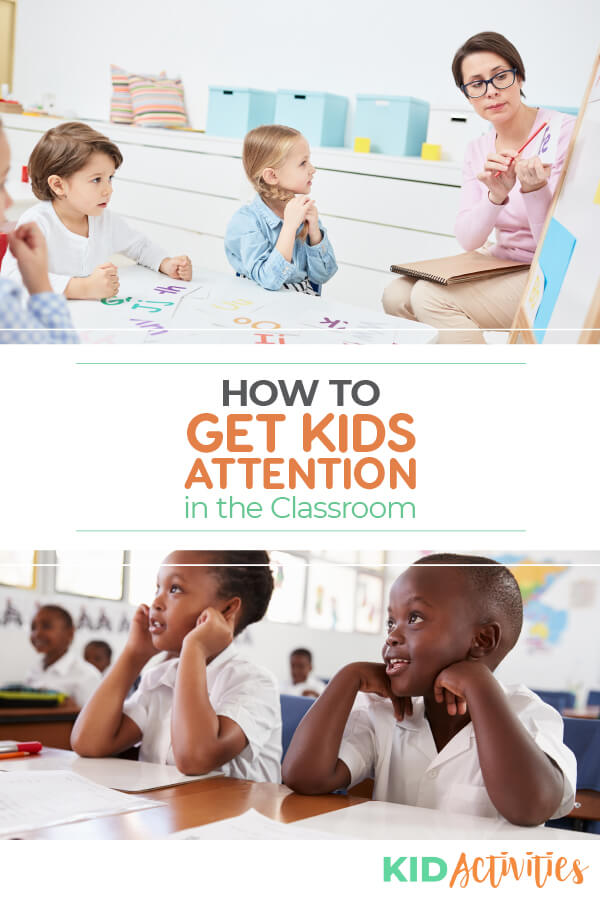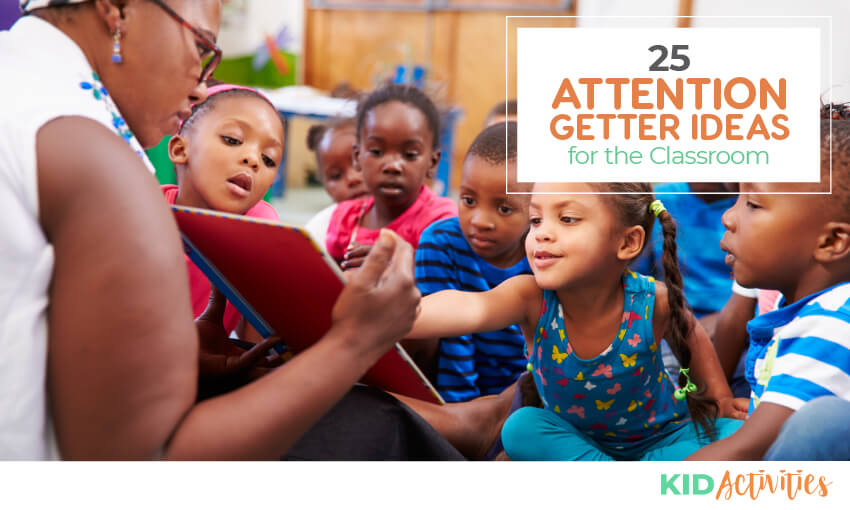Attention getters are a great way for a teacher to gain his students, well, attention! If your class is too noisy or busy with group activities, use these attention getters in a fun but effective way to gain the ear of the class again.
The idea here is to be interactive, and not passive, you start with the first line, the students need to follow up
Before starting with these attention getters, make sure your students understand how it works, take a few minutes to explain so everyone is on the same page. Depending on your own teaching style, you could use the same getter throughout the year, or switch them up as you like. It’s up to you.
Attention Grabber Ideas
1. Use a clapping pattern
Clap or tap in a pattern, for example, clap slowly twice and then clap fast three times. The students are to stop what they are doing and repeat the pattern. If necessary, do it again until all children have responded and are quiet. If your classroom or program used this method, there are many ideas that can be combined with this
2. Lights switched on/off
Children look at the caregiver and listen when the lights are flicked off and on.
3. Whistles
Whistles are harsh and can be annoying, however, they can be effective when outside or for an emergency.
4. The word “freeze!“
For an emergency or when attention is immediately desired, the word, “freeze,” works well. When the children hear the word,” they KNOW something is serious and important! Every program/classroom should have a ‘Freeze’ option in place!
5. Voices
When you say, “Voices,” teach the children to respond with a quiet, “Shh”, Use this if the children are too loud. If you want their attention, say, “Voices” again and they respond with a quieter, “Shhh…” Say it a third time very quietly, “Voices.” All children should be quiet and ready to listen.
6. Shout and Hush
Shout “AND A HUSH FELL OVER THE CROWD!” and the kids reply with a drawn-out “HUSH!”
7. Give Me Five
Hold up your hand and say, “Give me five.” The children put their hands in the air and shout “five!” As they count down to one, they get progressively quieter until “one” is said in a whisper. Or, after saying, “Give me five,” everyone puts their hand in the air and counts loudly using their fingers from 1 to 5.
8. Use the Mascot
Every school has a mascot. Shout your school name and have the children respond with the name of the school mascot. Example: The caregiver/teacher shouts, “Baldwin” and the children respond with, “Lions.” After they shout the mascot name they are to be silent.
9. Clapping
Just clapping is another way and you’ll get applause!
10. Do you need a moment of peace?
Tell your students that they will often be playing, “The Still Waters Game”, they will know the game has begun when you say, “1, 2, 3, – 3, 2, 1. still waters has begun.”
Ask them to freeze like an ice cube and remain silent when they hear that sentence. Time the children to see how long they can remain still. The goal is to beat their best time.
Hold your fist in the air and each time you see someone move or talk, put a finger up. Once you have all five fingers up, check your watch and tell the group how long they were able to remain still.
11. Bump-Da-Da-Bump-Bump
One favorite attention-getter is a teacher/leader saying, “Bump-da-da-Bump-Bump” and the children reply in unison, “Bump-Bump!” This is said to the tune of ‘Shave and a Hair Cut-Two Bits’.
12. Teacher Says
Use, “Teacher Says,” like, “Simon Says.” For example:
- “Teacher says, touch your nose,”
- “Teacher says, Clap once,” then
- “Teacher says, look at me.”
This can also be used to line up! Teacher says, “Line Up!”
13. Use Something That Makes Noise
For getting attention, you can: Shake a shaker, touch a wind chime, ring a bell, use a rain stick, play music or use any kind of sound maker as a signal for students to be attentive.
14. Sports Themed Incentive

Here is a fun transition INCENTIVE that can be used during football/baseball season! (For older kids)
FOOTBALL: On a large green poster board, draw a PROGRAM VERSION of a football field. -10-20-30-40 ← 50 → 40-30-20-10-
At the beginning of the school year, introduce the football chart. Place two small football cut-outs on the center 0-yard line with 50 yards at each end. Tell the kids that you’re going to play a game for six weeks. (Staff is one team and kids the other.)
Decide which transitions you’d like to shorten – explain that each day during that transition they will be timed. If everyone is ready within the time, the children score 10 yards. If not-staff scores.
The quarters are divided within weeks. At the end of the six weeks if the children won – celebrate with a “football-themed” event! You could also do a version of this for “cleaning up”-
No nagging and good job they get to score, if there are many reminders and lack of responsibility-the staff scores. You could also time this to end near Super Bowl weekend!
This can be adapted to just about any sport–as the baseball version image above demonstrates!
15. Laughing Handkerchief
When the group sees a handkerchief thrown into the air, they laugh as loud as possible. When the handkerchief hits the ground, they go silent.
16. Use humor!
Say in a robotic voice, “Ms. Linda to SAC (or Grade 2) – Come in Grade 2” and smile! This method is especially good when used with individual children.
- Other methods for getting individual attention: Engage children with your facial expressions, such as smiling and making eye contact; say “excuse me”; put your hand on child’s shoulder; obstruct the child’s view of activity.
- Be welcoming; use children’s names to get their attention. Use your body language to convey warmth and acceptance.
18. When Needing Attention
Instead of saying, “Boys and girls”. Say your “school’s name combined with SAC or Grade. (Or whatever your program/classroom is called) Example: Hampton Grade 2 – your attention is required.
19. Clap If You Can Hear Me
Say, in a normal tone of voice, “Clap once if you can hear me.” Those listening will quiet down and clap one time. Then say, “Clap twice if you can hear me.” More children respond with two claps. Finally say, “Clap three times if you can hear me.” By this time you should have the attention of your group. (Personally I never cared for this one-it can take longer than other methods but it is popular in many areas. Barb)
20. Keep A Schedule
Important: Post a schedule with approximate times of routine activities
- The schedule informs children of “What comes next”, this prepares the children for upcoming transitions.
- Student reminders are required to accustom the children to look at the schedule.
21. Sing a Song
For Pre-K to Grade 1- sing the following words to the Frere Jacques tune:
“Are you listening? Are you listening? Everyone! Everyone! If you are listening, if you are listening, look at me, look at me.” Other ways to end the song are: “Snap your fingers” or “Pat your head.”
22. Music
Click here to see comments on using music in transitions
23. The Why
Let the children know when they need to do something, give them the reason why it is necessary.
- Get into the habit of saying, ‘We’re going to, because”
- When children understand the ‘whys’, they are more apt to cooperate.
24. THE TALKING STONE, STICK OR MOUTH (Use with Pre-K and up!)
Often during circle or group time, many children want to talk at once. One way to help children learn how to take turns is to use a visual clue.
Teachers/caregivers might try using a “talking stick” or “talking stone”. You can use a colorful rock or decorate your stick in a special way. This technique helps young children learn to respect the speaker and to wait and listen. Continue with this idea and soon the children will be reminding each other.
This version is adapted from preschoolrainbow.org; however, I’ve used this method for the last 20 years when having group meetings with youth. I’ve made a “Talking mouth” out of a rolled-up pair of white socks and in the past used a stone and feather. It works!!! Until recently, I didn’t know that it has Native American origin. It was something I just thought of, 20 plus years ago! Barb
25. Use a Catchy Rhyme
Say to the students in a loud voice, “All set?” The answer, “You bet.”
Fun Idea
This chant can be used to facilitate classroom transitions. If your group/class is noisy, start chanting loudly, then lower your volume with each successive repetition.
For the next-to-last time, it is said, whisper the words. For the last repetition, only lip-sync or mouth the words.
BOOM CHICK BOOM!
I said a boom chicka boom
‘Students repeat’
I said a boom chicka boom.
‘Students repeat’
I said a boom chicka rocka
Chicka rocka, chicka boom
‘Students repeat’
I said a boom chicka boom.
‘Students repeat’
Oh yeah (echo), uh huh (echo), next time (echo)
A little softer (echo).
A little louder…
A little slower…
A little faster…
The end!!!
TIPS to getting attention in the class
1. To get children’s attention, use one method consistently. If you are committed to a method it will usually work, if you don’t commit 100%, it won’t work.
- Meet with the children at the beginning of the school year and discuss what method or methods you will use.
- Present a few ideas to them – and have kids decide which to use! Do this each year.
- You can add fun by keeping tally and charting their opinions.
2. Students will welcome any attempt you make to add transition activities into your daily routines, especially if they involve a little movement or a challenge. You will be surprised at how these activities change your group environment. If you periodically change the activities, you will keep their interest piqued as they wonder what you will do next.
3. Be sure all children know what is expected when these systems are used. Individual guidance may be necessary for children who have difficulty with transitions or are new to your program. With consistency, your group will easily follow the routine when they hear the selected music or signal!
A. Getting Attention: The first step for children to pay attention is the awareness that someone wants their attention. At times young children have a remarkable focus on what they are already doing; attention signals need to be strong enough to get through their present concentration.
B. Whatever strategies you’ve decided upon, the important thing is to have the children practice.
- For instance, if one of your choices is to use the “lights on and off method” tell the children the rule and then say, “Talk now and when I turn out the lights, stop. Ok, that was good, but a few people were talking; let’s try again”.
- Keep practicing the first week or two.
- Practice again, if you see it has stopped working or if many kids are not listening.
C. Be clear and specific.
Children are more likely to hear your requests and pay attention when it is clear what you want them to do.
- Keep directions short and simple.
- Allow children time to process your requests for their attention and follow the directions given.
- Consider that afternoons are low energy times for many children and it may take longer to process attention-getting techniques.
D. Be aware of temperament. Some children can be easily distracted and/or exhibit impulsive behavior.
When this is the case, speak calmly, use one-step directions, and give them a gentle touch.
E. Teach the difference between being silly and serious. Tell children that there is room for both of these behaviors.
- Practice by saying, “Act silly!” Let them be silly. Then say, “Now, act serious.”
- Model this at the beginning of the year so when you say, “I need to have serious behavior,” they respond accordingly and are attentive.
- Keep in mind that you may need to use more than one tool or idea to address children’s transition needs.
- Learning key strategies to keep your program on task will help you handle students who have trouble moving from one location to another-or switching from one activity to another.
- Keeping youth productive will gain more active program time in the process!
There you have it, 25 attention getter ideas for kids in the classroom. These are great ideas to help the kid’s attention and get them to quiet down and follow directions.
You may also be interested in:
- Clean Up Transitions for School-Age Kids
- Selecting Teams or Groups
- Games to Play While Waiting In Line


